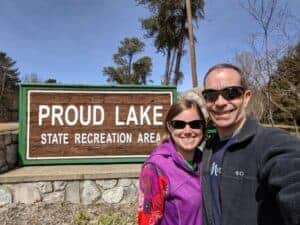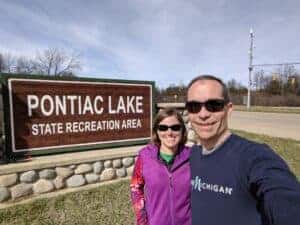After we had so much fun visiting five Michigan State Parks in one day, we decided to do it again. This time we visited only four parks to allow ourselves a bit more time at each park. Our day consisted of Highland Recreation Area, Proud Lake Recreation Area, Pontiac Lake Recreation Area, and Dodge #4 State Park.
 State Park vs. Recreation Area
State Park vs. Recreation Area
This seems like a good time to mention something you’re probably wondering, and we did too. What’s the difference between a state park and a state recreation area? The answer is simple, but nothing you’d figure out on your own; in fact, I had to ask someone at the Michigan Department of Natural Resources. State parks are considered closed to hunting unless posted open. State Recreation Areas are open to hunting unless posted closed. Bet you wouldn’t have guessed that!
This set of parks also is in Southeast Michigan, near the other parks we visited recently. As I mentioned in that blog, this area of the state has a lot of parks in relative proximity to one another, making it easy to jump from one to the other.
I was extremely surprised by what we found at the parks we visited on this trip, especially when it came to the history behind a couple of them, as well as the amenities and activities offered.
So let’s find out all the things you can do when you visit.
Highland Recreation Area

However, as we soon learned, once we drove into the park and found the trails we felt as if we’d entered a different world. We found mostly silence except for the peaceful sounds of birds, frogs, and other woodland wildlife. It was exactly the relaxing atmosphere we love.

Highland Recreation Area encompasses what used to be Edsel Ford’s retreat, which he named Haven Hill. In the 1920s, he purchased 2,400 acres of land for his family to use as a getaway and working farm. After his unexpected early death, his widow sold the land to the state to be used for a state park. (Look for a separate blog post about Haven Hill during its heyday and what buildings are still left that you can explore.)
Today, Highland Recreation area is 5,900 acres. It has a vast trail system — more than 45 miles worth — for hikers, equestrian riders, mountain bikers, and skiers. Dogs are allowed in certain sections of the trails.
Part of these trails is located in a section of the park called Haven Hill Natural Area. Designated in 1976 as a National Natural Landmark, the area has largely been undisturbed for the past 75 years and features a wide variety of forest types.
The park features three different day-use areas for picnics, swimming, horseshoes, or volleyball, as well as areas for metal detecting and, in the winter, snowmobiling. Access sites are located on four lakes within the park for fishing and recreational boating.
A rustic 30-site campground is available to campers with and without horses. The sign said it is equestrian-only until May 20th, then open to everyone. However, as we encountered elsewhere, the campground was not yet open in early April. A group camping area in a field was open, and it appeared a Boy Scout troop was making good use of it the weekend we visited.
We spent the majority of our time at Highland Recreation Area hiking and visiting some of the old historical sights. The trail was mostly well-marked except for a couple of sections. A main intersection was missing its marker, causing us to go about a mile out of our way. In the end, it was a serendipitous wrong-turn as we ended up on a wonderful wooded trail we wouldn’t have explored otherwise. I suppose this is where I should note that a good section of the trails include a pretty steep uphill because Ford built his retreat on the highest point in Oakland County. So bring plenty of water and snacks if you plan to explore.
This is an awesome state park, but the Department of Natural Resources doesn’t have any information about the Ford history or the buildings on its website, so we had no idea any of it was there until we arrived. It was our first stop of the day and we’d only planned about 1.5 hours for this park. Instead, we spent almost 4, and we still didn’t get to see everything we wanted. I feel not advertising the Ford history is a major disservice, as you could easily skip over this park if you thought it was “just another trail system.”
I highly recommend Highland Recreation Area! History buffs will really love it. Casual nature lovers and hikers will, too. I can’t wait to go back and spend all day exploring.
Proud Lake Recreation Area

With 4,700 acres, it consists of what I’d consider three separate sections: the campground, the trails and conference center, and the aquatic activities.
Proud Lake Recreation Area is located on the Huron River in Oakland County. It has 20 miles of trails through several diverse habitats. There are designated hiking and skiing trails, and a separate bridle and biking trail system. While most trails we encounter are multi-use, many of the hiking trails here are specifically marked as not allowing bikes.

Sometimes, you have to visit a place to find things you didn’t even know existed. For example, Proud Lake Recreation Area is a portage point for the Huron River Water Trail, which is part of the National Water Trail. Once you make it over this portage, you are 103 miles from Lake Erie.
As I mentioned, state recreation areas have land that is open to hunting. Proud Lake Recreation Area has trails that go through these areas so be sure you’re wearing your safety hunter orange and be aware of your surroundings if you’re out during hunting season. There are signs warning you as you cross through the hunting zones.
The campground seemed nice and I was pleased to see plenty of campers in early April. The state built the campground into a hill, which means there are one or two rows of sites that essentially sit above and overlook the bottom two rows. All sites are back to back, with no privacy in between. Even though the campground is next to Proud Lake, we did notice there are no sites directly next to the water.
A unique feature of the park is the River Hawk Lodge and conference center, featuring overnight accommodations, a community room, a large kitchen, a large conference room, and other amenities. Both facilities are available to rent for family gatherings, hunting parties, work retreats, meetings, weddings, or other events.
Unfortunately, we ran out of time and did not get to visit the third section of the park that is across the road. This area features the biking and bridle trails, as well as the canoe and kayak rental facilities. Since it was only 50 degrees, we decided we’d come back when it was warmer to try out the river.
Overall this was a nice park and it was quite busy the day we visited, with lots of people walking the trails and folks of all ages trying their hand at fishing.
Pontiac Lake Recreation Area

Due to its popularity, the park features a vast day-use area with a ½ mile of sandy beach, playground equipment, four shelters, and more picnic tables and grills than we could count. Be prepared for people to pack the place on summer weekends!

Another activity we’ve only seen at a couple of other parks is a model airplane flying field. I grew up with one of these near my house, but I never realized how popular they are or that they were at state parks. So if this is an activity you enjoy, there seem to be a decent number of location options.
Three different campground areas are available: the aforementioned equestrian campground, a modern campground, and a group campground. What I noticed, however, is that none of them are anywhere near the day-use area. So if you are camping and want to visit the beach, you’d either need to drive a considerable distance of a couple of miles or go for an extensive hike.
Dodge #4 State Park

The Dodge Brothers Corporation donated the land that encompasses Dodge #4 in 1922. It was actually part of 11 different parcels totaling 600 acres of land. The Dodges donated the land with the stipulation that it remain available for the public. Out of the original 11 Dodge parks, it appears that Dodge #4 is the only stand-alone park left under state control. Most of the others have either been turned over to local control or they have been absorbed into other recreation areas. (For example, Dodge #10 became part of the Highland Recreation Area.)
There is much more history to share regarding the Dodge brothers and why the parks were so important to the area and the state which you can read about on the state’s website.
The park sits along a mile of shoreline on Cass Lake and includes a small beach and grassy space to hang out. It also has benches, a public boat launch, sand volleyball, playground, and picnic areas. There is even a boardwalk along the water that connects the beach area to the picnic area.
Even though Dodge #4 is on the smaller side, it seems to be popular. There were lots of cars passing through while we were there. And families and couples of all ages were using the park and strolling along the shoreline.
Historical musings on state parks
We found it fitting that we started our day with land donated by the Ford family and ended it with land donated by the Dodge family. These automotive pioneers were major influencers and contributors to Michigan’s history in many ways that most people don’t realize. From their vehicle innovations to their philanthropy and visions for the future, they paved the way for what we enjoy today.
One reason for our state parks project is to learn more about the history of our state. We all take for granted these tranquil spots of green without giving any thought to how they came to be. It’s important to realize that someone had the foresight to preserve this land from development; to keep it pristine and untouched for future generations to enjoy.
I hope next time you visit a park you stop to reflect on its history and those responsible for making it a reality.
We have plenty more adventures to come, so subscribe to this blog and our YouTube channel. (We have a video about the four parks above published there.) You can follow us on Instagram, our Facebook page, and Twitter. Plus, you can see our progress as we visit each park on this interactive Google Map. You also can keep track of our activities on social media with the hashtags #hikecampgo and #mistateparks100.

 State Park vs. Recreation Area
State Park vs. Recreation Area